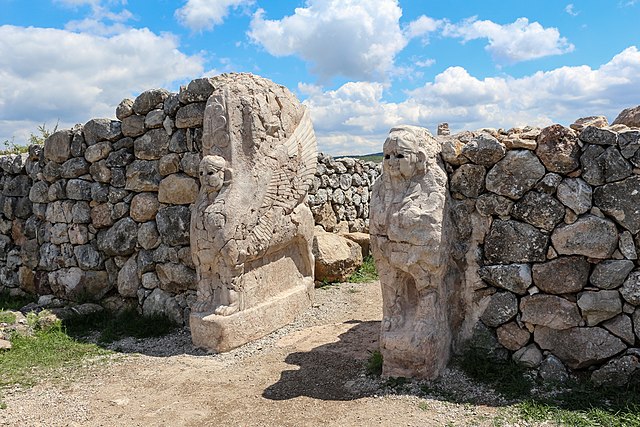The Luwians were an ancient people in Anatolia who spoke the Luwian language. During the Bronze Age, Luwians formed part of the population of the Hittite Empire and adjoining states such as Kizzuwatna. During the Hittite New Kingdom, Luwian replaced Hittite as the empire's dominant language. In the early Iron Age, a number of Luwian-speaking Neo-Hittite states arose in northern Syria. The Luwians are known largely from their language, and it is unclear to what extent they formed a unified cultural or political group.
Luwian storm god Tarḫunz in the National Museum of Aleppo.
Statue from the Post-Hittite period, representing king Šuppiluliuma, ruler of the Luwian state of Pattin (Unqi)
Anatolia, also known as Asia Minor, is a large peninsula located in West Asia and a region of Turkey, constituting most of its contemporary territory. Geographically, the Anatolian region is bounded by the Mediterranean Sea to the south, the Aegean Sea to the west, the Turkish Straits to the north-west, and the Black Sea to the north. The eastern and southeastern boundary is either the southeastern and eastern borders of Turkey, or an imprecise line from the Gulf of Iskenderun to the Black Sea. Topographically, the Sea of Marmara connects the Black Sea with the Aegean Sea through the Bosporus strait and the Dardanelles strait, and separates Anatolia from Thrace in the Balkan peninsula of Southeastern Europe.
The henges in Göbekli Tepe were erected as far back as 9600 BC.
The Sphinx Gate in Hattusa
The Theatre at Halicarnassus (modern Bodrum) was built in the 4th century BC by Mausolus, the Persian satrap (governor) of Caria. The Mausoleum at Halicarnassus was one of the Seven Wonders of the Ancient World.
The Library of Celsus in Ephesus was built by the Romans in 114–117. The Temple of Artemis in Ephesus, built by king Croesus of Lydia in the 6th century BC, was one of the Seven Wonders of the Ancient World.






